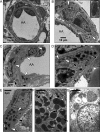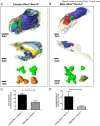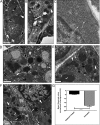Phenotypic dissection of the mouse Ren1d knockout by complementation with human renin
- PMID: 29123029
- PMCID: PMC5787795
- DOI: 10.1074/jbc.RA117.000160
Phenotypic dissection of the mouse Ren1d knockout by complementation with human renin
Abstract
Normal renin synthesis and secretion is important for the maintenance of juxtaglomerular apparatus architecture. Mice lacking a functional Ren1d gene are devoid of renal juxtaglomerular cell granules and exhibit an altered macula densa morphology. Due to the species-specificity of renin activity, transgenic mice are ideal models for experimentally investigating and manipulating expression patterns of the human renin gene in a native cellular environment without confounding renin-angiotensin system interactions. A 55-kb transgene encompassing the human renin locus was crossed onto the mouse Ren1d-null background, restoring granulation in juxtaglomerular cells. Correct processing of human renin in dense core granules was confirmed by immunogold labeling. After stimulation of the renin-angiotensin system, juxtaglomerular cells contained rhomboid protogranules with paracrystalline contents, dilated rough endoplasmic reticulum, and electron-lucent granular structures. However, complementation of Ren1d-/- mice with human renin was unable to rescue the abnormality seen in macula densa structure. The juxtaglomerular apparatus was still able to respond to tubuloglomerular feedback in isolated perfused juxtaglomerular apparatus preparations, although minor differences in glomerular tuft contractility and macula densa cell calcium handling were observed. This study reveals that the human renin protein is able to complement the mouse Ren1d-/- non-granulated defect and suggests that granulopoiesis requires a structural motif that is conserved between the mouse Ren1d and human renin proteins. It also suggests that the altered macula densa phenotype is related to the activity of the renin-1d enzyme in a local juxtaglomerular renin-angiotensin system.
Keywords: animal model; confocal microscopy; electron microscopy (EM); granulation; human renin; immunochemistry; juxtaglomerular; macula densa; mouse; renin; renin angiotensin system; secretion; transgenic mice.
© 2018 by The American Society for Biochemistry and Molecular Biology, Inc.
Conflict of interest statement
The authors declare that they have no conflicts of interest with the contents of this article
Figures







Similar articles
-
Renin-1 is essential for normal renal juxtaglomerular cell granulation and macula densa morphology.J Biol Chem. 1997 Jul 18;272(29):18185-90. doi: 10.1074/jbc.272.29.18185. J Biol Chem. 1997. PMID: 9218454
-
Granulation rescue and developmental marking of juxtaglomerular cells using "piggy-BAC" recombination of the mouse ren locus.J Biol Chem. 2000 Dec 22;275(51):40378-84. doi: 10.1074/jbc.M007315200. J Biol Chem. 2000. PMID: 10995772
-
Tubular signal for the renin activity in the juxtaglomerular apparatus.Kidney Int Suppl. 1982 Aug;12:S55-62. Kidney Int Suppl. 1982. PMID: 6752539
-
Confocal imaging and function of the juxtaglomerular apparatus.Curr Opin Nephrol Hypertens. 2005 Jan;14(1):53-7. doi: 10.1097/00041552-200501000-00009. Curr Opin Nephrol Hypertens. 2005. PMID: 15586016 Review.
-
Regulation of renin synthesis in the juxtaglomerular cells.Curr Opin Nephrol Hypertens. 1996 Jan;5(1):16-9. doi: 10.1097/00041552-199601000-00005. Curr Opin Nephrol Hypertens. 1996. PMID: 8834157 Review.
Cited by
-
Advances in use of mouse models to study the renin-angiotensin system.Mol Cell Endocrinol. 2021 Jun 1;529:111255. doi: 10.1016/j.mce.2021.111255. Epub 2021 Mar 28. Mol Cell Endocrinol. 2021. PMID: 33789143 Free PMC article. Review.
References
-
- Hackenthal E., Paul M., Ganten D., and Taugner R. (1990) Morphology, physiology, and molecular biology of renin secretion. Physiol. Rev. 70, 1067–1116 - PubMed
-
- Steppan D., Zügner A., Rachel R., and Kurtz A. (2013) Structural analysis suggests that renin is released by compound exocytosis. Kidney Int. 83, 233–241 - PubMed
Publication types
MeSH terms
Substances
Grants and funding
LinkOut - more resources
Full Text Sources
Other Literature Sources
Molecular Biology Databases

